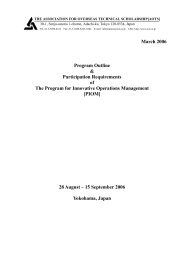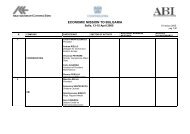Analysis of the Operation and Financial Condition of the Enterprise
Analysis of the Operation and Financial Condition of the Enterprise
Analysis of the Operation and Financial Condition of the Enterprise
You also want an ePaper? Increase the reach of your titles
YUMPU automatically turns print PDFs into web optimized ePapers that Google loves.
<strong>Analysis</strong> <strong>of</strong> <strong>the</strong> <strong>Operation</strong> <strong>and</strong> <strong>Financial</strong> <strong>Condition</strong> <strong>of</strong> <strong>the</strong> <strong>Enterprise</strong>turnover ratioBy looking at Table 5.6 it can be seen that just like for <strong>the</strong> current asset ratio <strong>the</strong>total asset turnover ratio is higher particularly in <strong>the</strong> second half <strong>of</strong> <strong>the</strong> year, because <strong>the</strong>net turnover <strong>of</strong> <strong>the</strong> enterprise is higher at that time. All assets <strong>of</strong> <strong>the</strong> enterprise are turnedover at least two times during a year.Rate <strong>of</strong> turnover <strong>of</strong> accounts receivableFor <strong>the</strong> purposes <strong>of</strong> assessing this ratio <strong>the</strong> formula for calculation <strong>of</strong> <strong>the</strong> rate <strong>of</strong>turnover <strong>of</strong> accounts receivable 4.19 is used. In order to estimate <strong>the</strong> rate <strong>of</strong> turnover <strong>of</strong>accounts receivable <strong>the</strong> average amount <strong>of</strong> debtors’ debts as well as <strong>the</strong> figure <strong>of</strong> netturnover must be known for each period, which must be adjusted, for example, <strong>the</strong> netturnover figure for Quarter 1 has to be multiplied by 4, <strong>the</strong> net turnover figure for Quarter 2– by 2, <strong>the</strong> net turnover figure for Quarter 3 has to be divided by 3 <strong>and</strong> multiplied by 4,while no adjustment has to be made to <strong>the</strong> net turnover figure <strong>of</strong> Quarter 4.To find out <strong>the</strong> number <strong>of</strong> days for turning over <strong>the</strong> accounts receivable, <strong>the</strong>number <strong>of</strong> days in a year must be divided by <strong>the</strong> rate <strong>of</strong> turnover <strong>of</strong> accounts receivable(see Table 5.7).Table 5.7Estimate <strong>of</strong> <strong>the</strong> <strong>Enterprise</strong> N rate <strong>of</strong> turnover <strong>of</strong> accounts receivable for <strong>the</strong>period from 31/03/2XX8 to 31/12/2XX9 (in CU)March,2XX8June,2XX8Sept.,2XX8Dec.,2XX8March,2XX9June,2XX9Sept.,2XX9Dec.,2XX9Net turnover 150 046 347 023 723 868 1074683 243 435 533 788 846 876 1166073Adjusted netturnover 600184 694046 965157 1074683 973740 1067576 1129168 1166073Accountsreceivable 99 150 111 292 167 202 207 862 289 186 219 634 195 662 170 200Average value <strong>of</strong>accounts receivable 97921 105221 139247 187532 248524 254410 207648 182931Rate <strong>of</strong> turnover <strong>of</strong>accounts receivable 6,13 6,60 6,93 5,73 3,92 4,20 5,44 6,37Length <strong>of</strong>turnover <strong>of</strong>accounts receivablein days 60 55 53 64 93 87 67 57When looking at Table 5.7 ‘Estimate <strong>of</strong> <strong>the</strong> <strong>Enterprise</strong> N rate <strong>of</strong> turnover <strong>of</strong>accounts receivable for <strong>the</strong> period from 31/03/2XX8 to 31/12/2XX9’ it can be noticed that<strong>the</strong>re is a considerable decrease in <strong>the</strong> rate <strong>of</strong> turnover <strong>of</strong> accounts receivable during <strong>the</strong>period when <strong>the</strong> net turnover figure <strong>of</strong> <strong>the</strong> enterprise is among <strong>the</strong> lowest. The reason forthis is that overdue debtors’ debts constitute one third <strong>of</strong> <strong>the</strong> total amount <strong>of</strong> accountsreceivable, <strong>the</strong> delay exceeding 120 days <strong>and</strong> <strong>the</strong>ir collection has become problematic.During <strong>the</strong> period, when <strong>the</strong> turnover <strong>of</strong> <strong>the</strong> enterprise is decreasing, <strong>the</strong> amount <strong>of</strong>accounts payable decreases too. The smaller <strong>the</strong> amount <strong>of</strong> accounts receivable, <strong>the</strong> higheris <strong>the</strong> percentage <strong>of</strong> <strong>the</strong> difficult debtors’ debts from <strong>the</strong> total accounts receivable.98
















